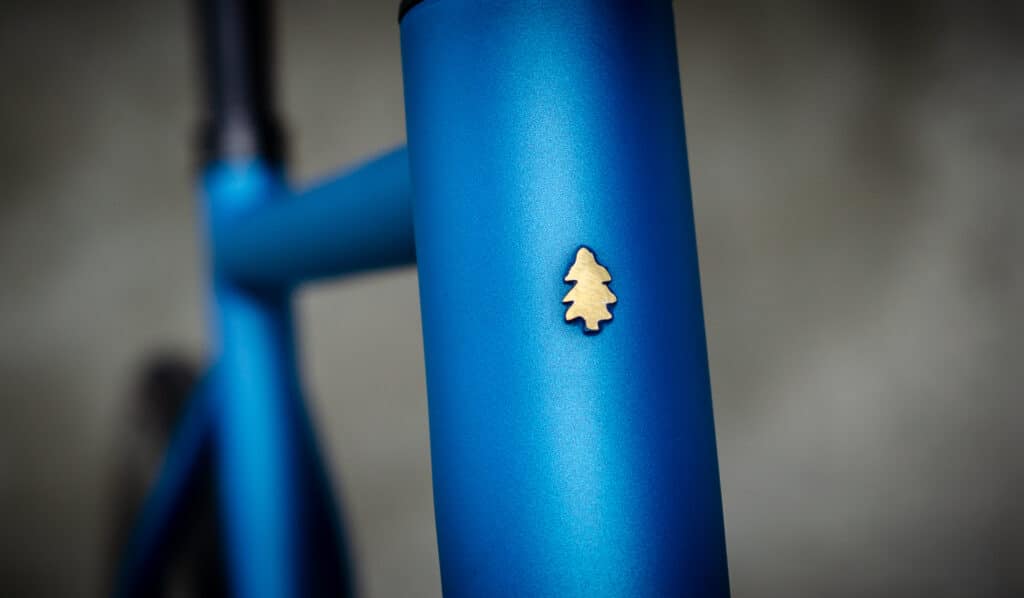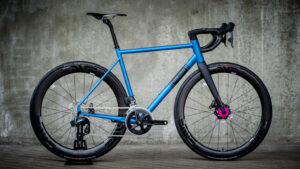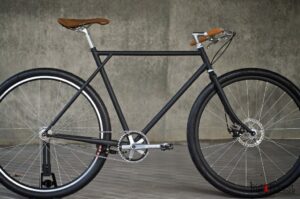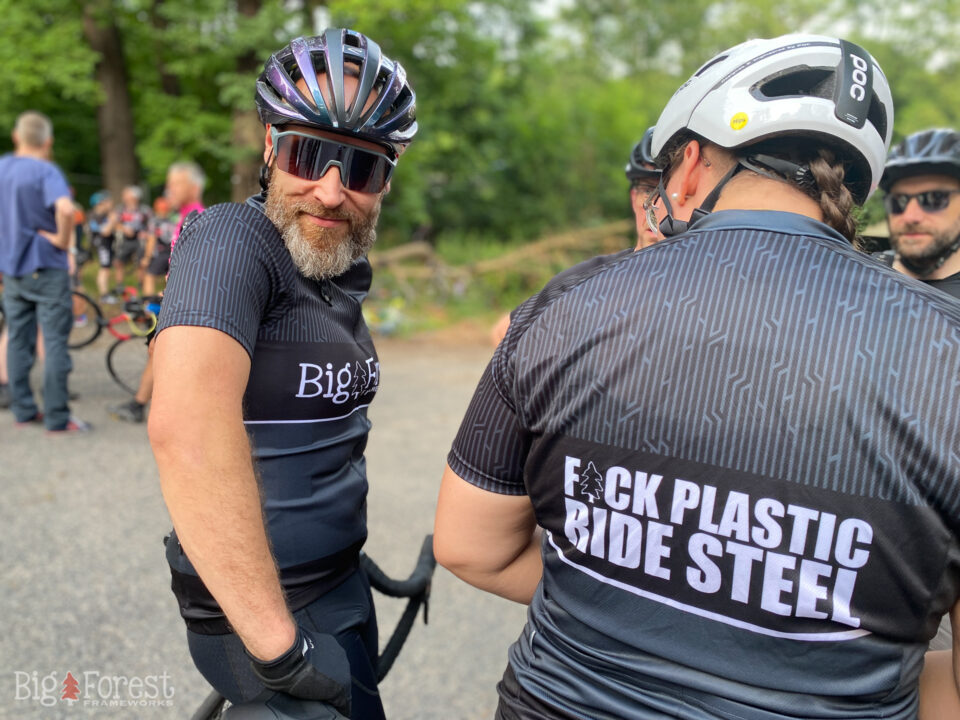
Where to Stay in Potsdam/Babelsberg
12. September 2023
BSA or T47 Bottom Bracket Standard for Your New Steel Frame?
13. September 2023For your frame at Big Forest Frameworks there are a few different head tube standards that are possible. Most of the people that come here for a course, or order a frame/bike, want a modern road or gravel bike with disc brakes. They are also looking for a more modern look, with larger diameter tubing than was typical 30 or 40 years ago. Most people also choose a carbon fork, as with their wider fork blades this fits well to the larger diameter tubing. They are also quite a bit lighter than steel forks. Most carbon forks these days also have a tapered steer tube, either 1 1/2 or 1 1/4 diameter at the bottom. All these points combined, lead most people to go with the straight 44mm steerer tube, like you see here:
The lower bearing cups are external (EC), and the upper bearing cups are Zero Stack (ZS) or also called semi-integrated. The correct terms for these are ZS44/28,6 the upper cup, and either EC44/33 for a 1 1/4 tapered steerer, or EC44/40 for a 1 1/2 steerer.
Another option is the 34/44 tapered head tube from Columbus. You can see it here on our Talugrabi:
Both bearing cups are EC (external). The inside diameter (ID) at the bottom is 44mm (like the straight 44mm head tube above) and the upper ID is 34mm, which is the ‘old’ 1 1/8 inch threadless standard. There aren’t very many complete headsets that you can find for this combination, but Chris King does have them, as well as Columbus. But, if you know what you need, most of the time you can buy the upper and lower cups separately, and that opens up the possibilities quite a bit. The 34/44 tapered works well with the somewhat smaller diameter tubing that perhaps you are used to for steel frames. However the tube set of the Talugrabi pictured above is still called ‘Double Over-Size’, meaning that the down tube and top tube diameters are both two sizes up from what was found on the classic steel bikes of the 70s and 80s.
I like both. It is easier to build a frame with the straight 44mm tube because you can miter the tube with a normal hole saw, which is how things are normally done. With the tapered 34/44 head tube, the miter needs to be made by hand with the feil, which takes a bit of extra time.
Then there is the ‘new kid on the block’ from Columbus, offered since 2022, it is a straight head tube with a 54mm inner diameter, with braze in cups at the top and bottom. This gives you an IS52 headset standard at the top and bottom. There also aren’t too many headsets available for this standard, but Deda, FSA, and ENVE have them. Why an even bigger head tube? With the right headset, your frame can be built for fully integrated cables. The cables run through the bars, the stem, and into the head tube. Then the front brake goes into the fork, and the other cables into the down tube and further towards the back. It gives you a very clean look, you only see a bit of the cable where it exits.
Fully integrated cables are also possible with the straight 44mm head tube. You only need the right headset. These are at the time of writing quite uncommon, but ENVE and Chris King have them. Prepare yourself for the price, though, the ‘Aeroset’ from Chris King has a list price of $450! The headset from ENVE is around 100 Euro. The cups here, at least in the case of ENVE, are just adaptors from the 44mm head tube to IS52. Pretty cool idea. The bearings and top cap are the same. The advantage here is that the head tube diameter doesn’t get too big. The disadvantage is that the transition from the top of the head tube to the stem is not quite as nice as with the 54mm head tube.
If you want to build a modern road bike with fully integrated cable, and you want to run electric shifting (di2, AXS, Campa wireless), I prefer the 54mm IS52 standard. The head tube is huge, but you get used to it, and built up it looks great. Here is an example:
Then there are the ‘old’ standards for forks with a straight steerer tube, either 1 1/8 threadless, or 1 inch threaded. For 1 1/8 the head tube has an inner diameter of 34mm at the top and bottom. This takes a ‘classic’ headset with external cups at the top and bottom. It is called EC34/28,6 at the top, and EC34/30 for the bottom. Here is an example:
For the 1 inch threaded standard, the head tube has an inner diameter of 30.0mm, and the correct name is EC30/25.4 at the top, and EC30/26.4 at the bottom. However there are different standards for the crown race seat diameter. 26.4 is the most common today, but there are others still available to buy new today. A 1-inch head tube/headset usually takes a quill stem, like you see here:
Quill stems allow you to change the height of the bars whenever you want (and have a wrench that fits) which is an advantage. With the threadless stem (ahead) the steerer is usually cut at the appropriate length and the bars can’t be raised any more. With the threadless system you can tension the headset with just a 4 or 5mm hex key, with the quill stem you need one or two 34 or 36mm wrenches, which you probably don’t take with you on a long ride. The quill stem also simply gives the bike a more classical look. The classic race bikes all had quill stems. The ahead system developed along with the more modern aluminum race bikes of the later 80s.
So lots of standards to choose from! If you’re lost just ask and I will help you to make a decision.
Ever think about building your own frame? We offer frame building courses!












